Hawaii's Incredible (Edible)
Escargot
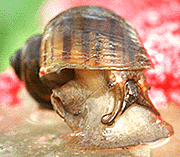
Pomacea canaliculata, better known as the apple snail.
Photos by Ken Ige, Star-Bulletin

Pomacea canaliculata, better known as the apple snail.
Photos by Ken Ige, Star-Bulletin
Apple snail eggs, below,
are roughly the color of cranberry juice.
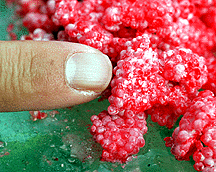 ONE person's trash is another person's treasure, just as one person's pest is another's delicacy.
ONE person's trash is another person's treasure, just as one person's pest is another's delicacy.Witness:Pomacea canaliculata, better known as the apple snail.
The 2-inch round gastropod with a thin gold or brown shell is a threat to the indigenous staple of Hawaii - taro. An estimated 95 million apple snails have infested the wetland taro paddies of Maui's Keanae and Waialua Nui peninsulas, according to aquaculture specialist Clyde Tamaru of the University of Hawaii Sea Grant Extension Service and the state Department of Land and Natural Resources. The state Department of Agriculture has designated the apple snail a pest, he added.
Below, Francis Hun sprinkles protein feed into a snail tank.
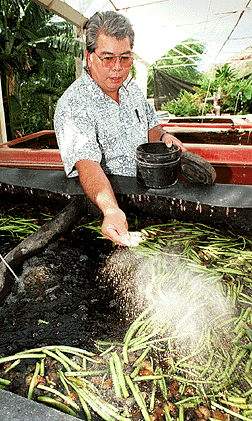 However, the apple snail also is Hawaii's freshwater version of escargot, the edible garden snail long revered as a French gourmet delicacy.
However, the apple snail also is Hawaii's freshwater version of escargot, the edible garden snail long revered as a French gourmet delicacy.
Francis and Tylette Hun, proprietors of BoKe Farms in Waianae (696-8464), raise Hawaiian escargot, an edible delicacy that's fast and easy to prepare and contains negligible fat.
The Huns raise escargot in a unique miniature ahupua'a system, replicating the traditional Hawaiian land division stretching from mountain to sea. In an ahupua'a - a self-contained farming/fishing district like a watershed - water runs from mountains down fish- and shrimp-filled streams, through lo'i (taro patches) and into the ocean, where it evaporates to form rain.
The Huns' miniature ahupua'a sits on a slope, where gravity carries water from snail tanks, to sunfish tanks, to taro lo'i, to catfish "ponds." Then, the water is pumped electrically to the top of the circuit and recycled. The farm's water bill totals $106 a month.
Edible crops thrive at each stage of the ahupua'a. Waste matter from the snails and sunfish provide calcium-rich fertilizer for the lo'i. Seventy-seven 4-foot square fiberglass tanks each house 3,000 to 5,000 snails, Hun said.
The escargot is harvested, cleaned and frozen in vacuum packs for $20 per pound, or 90 to 110 snails.
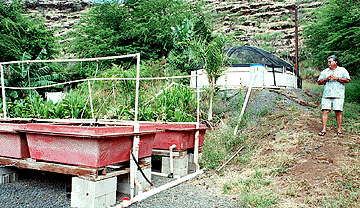
Hun and his miniature ecosystem.
"The big difference is the freshness," Leterc said. "The escargot used in Hawaii is fresh. Canned is not fresh. This (Hawaiian) escargot is fresh to your restaurant. It's a little bit crunchy, you can feel the freshness. It's not old produce. The taste is very nice."
Maui's Ritz-Carlton Kapalua, Roy's Restaurant Hawaii-Kai and 3660 On The Rise serve Hawaiian escargot.
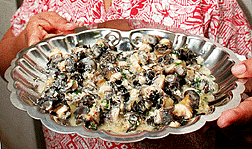 "They love it, it's a favorite of our customers since they first came out a couple of years ago," said Roy's corporate chef and partner Gordon Hopkins. He said BoKe Farms Escargot Cassoulet is a popular appetizer special.
"They love it, it's a favorite of our customers since they first came out a couple of years ago," said Roy's corporate chef and partner Gordon Hopkins. He said BoKe Farms Escargot Cassoulet is a popular appetizer special.
"We pan-saute it with roasted potato, garlic bits, pieces of braised short ribs, spinach and a little tomato; then put it on a bed of polenta," Hopkins said.
At 3660 On The Rise, chef Jim Gillespie sautes Hawaiian escargot and serves it with a mushroom sherry cream over grilled baguettes.
Isle palates can sample Hawaiian escargot at cooking demonstration/samplings:
Who: Chef Jim Gillespie prepares sauteed Hawaiian escargot with puff pastry in a garlic sherry cream and three other dishes plus wine
Where: 3660 On The Rise restaurant, Kaimuki
When: 6 p.m. Monday
Cost: $40
Reservations: 737-1177
Sampling also at: Made in Hawaii Festival
Where: Blaisdell Exhibition Hall
When: 5 to 8 p.m. May 17; 10 a.m. to 8 p.m. May 18; 10 a.m. to 4 p.m. May 19
Admission: $2 ($1 off coupons at First Hawaiian Bank and Bank of Hawaii supermarket branches
Information: 533-1292
Leterc suggests sauteing Hawaiian escargot with a classic French touch of butter, garlic, parsley and salt. "I think the best is a simple way if you really want to see the quality, flavor and texture."
1 pound Hawaiian escargot, about 90 piecesDefrost escargot and drain in colander.
1 can coconut milk
2 tablespoons green or red
curry paste, available in Asian section of supermarkets
2 tablespoons nam pla (fish sauce, or patis)
1 tablespoon brown sugar
1 tablespoon lemon grass, chopped
4 or 5 basil leaves or to taste
2 keffir lime leaves, available in Asian markets
Salt to taste
1 can pre-sliced bamboo shoots
Basil leaves for garnish, optional
In a pan over medium-low heat, bring coconut milk to a slow bubble. Add curry paste and continue heating while blending paste thoroughly into coconut milk.
Add nam pla, sugar, lemon grass, 4 or 5 basil leaves, keffir leaves and salt; heat 1 or 2 minutes. Add bamboo shoots and heat until mixture starts to bubble. Add escargot and cook until heated through, 1 to 2 minutes.
Garnish with basil leaves, if desired. Makes 6 servings.
12 Hawaiian escargotDefrost escargot and drain thoroughly in a colander.
1 (5 ounce) serving cooked fresh linguine, penne or other pasta
1 teaspoon olive oil
Salt and pepper to taste
1 tablespoon butter
1/2 tablespoon fresh garlic, chopped
1 tablespoon fresh American parsley, chopped
1/2 cup cream, optional
Drizzle olive oil over hot pasta and toss with salt and pepper to taste.
In a saute pan, heat butter until it "sings" (sizzles). Add garlic, parsley and salt to taste; saute until ingredients "sweat." Add escargot and saute quickly, about 30 seconds. Serve immediately atop hot pasta. Makes 1 serving.
Options: Add cream to escargot and cook 1 or 2 minutes longer; or toss the cream with hot pasta before topping with escargot. For other "great, flavorful" variations, toss the hot pasta with saffron or curry powder or various herbs or spices to taste.
3-1/3 pounds Hawaiian escargot (about 300 pieces)Put defrosted escargot on skewers, 5 per skewer.
60 bamboo skewers
Spicy sauce:
3 cups soy sauce
1-1/2 cups mirin, or Japanese rice wine
1/2 cup sugar
1/4 cup chopped green onion
3-inch piece fresh ginger, thinly sliced and pounded
6 (2-1/2 inch long) Korean chile peppers (available at Korean markets such as Kapalama Market), split lengthwise
1/2 capful vinegar
3 drops sesame oil
Combine sauce ingredients in a flat-bottomed frying pan; heat until sauce comes to a sizzle. Add skewered snails in a single layer and cook 30 seconds or until color changes and size starts to reduce slightly. Turn skewers once during cooking. Makes 60 pupu skewers or 20 servings.